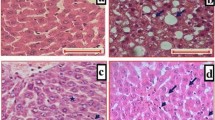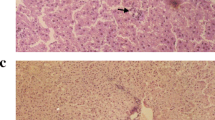Abstract
Our objective was to explore the restorative effect of taurine on experimental nonalcoholic steatohepatitis (NASH). Thirty-six SD rats were randomly divided into three groups, 12 in each group: the normal group was fed standard rat diet; the model group and the treatment group were both fed a high-fat rat diet for 12 weeks, and the rats in the treatment group were simultaneously injected with taurine subcutaneously for 8 weeks. Hepatic histological change was observed; TNF-α and TGF-β1 protein expression was identified by immunohistochemistry; mRNA expression of TNF-α, TGF-β1, type I procollagen, and adiponectin was measured by RT-PCR; body weight, weight gain, liver weight, and liver index were measured; and biochemical parameters monitored included serum transaminases, serum lipids, fasting plasma glucose, and hepatic level of oxidative stress. Rats in the model group showed a significant increase in liver weight, liver index, serum transaminase activities, serum triglyceride, fasting plasma glucose, and oxidative stress; the mRNA expression of TNF-α, TGF-β1, and type I procollagen increased, whereas the expression of adiponectin decreased significantly, compared with that in the normal group. The typical hepatic lesions of NASH were observed histologically in the model group. Taurine treatment resulted in a significant decrease in liver weight, liver index, serum transaminase activities, serum triglyceride, fasting plasma glucose, and oxidative stress; the mRNA expression of TNF-α, TGF-β1, and type I procollagen decreased, but the expression of adiponectin increased significantly, compared with that in the model group. Histological improvement was observed in the treatment group. In conclusion, taurine could inhibit lipid peroxidation, improve lipid and glucose metabolism, decrease synthesis of TNF-α and TGF-β1, promote synthesis of adiponectin, and have a restorative effect on experimental NASH.






Similar content being viewed by others
References
Day CP, James OFW (1998) Steatohepatitis: A tale of two “hits”? Gastroenterology 114:842–845
Lefkowitch JH, Haythe JH, Regent N (2002) Kupffer cell aggregation and perivenular distribution in steatohepatitis. Mod Pathol 15:699–704
Hui JM, Hodge A, Farrell GC, Kench JG, Kriketos A, George J (2004) Beyond insulin resistance in NASH: TNF-alpha or adiponectin? Hepatology 40:46–54
Lee KS, Buck M, Houglum K, Chojkier M (1995) Activation of hepatic stellate cells by TGF alpha and collagen type l is mediated by oxidative stress through c–myb expression. J Clin Invest 96:2461–2468
Berg AH, Combs TP, Du X, Brownlee M, Scherer PE (2001) The adipocyte-secreted protein Acrp30 enhances hepatic insulin action. Nat Med 7:947–953
Combs TP, Berg AH, Obici S, Scherer PE, Rossetti L (2001) Endogenous glucose production is inhibited by the adipose–derived protein Acrp30. J Clin Invest 108:1875–1881
Rajala MW, Scherer PE (2003) Minireview: the adipocyte—at the crossroads of energy homeostasis, inflammation, and atherosclerosis. Endocrinology 144:3765–3773
Obinata K, Maruyama T, Hayashi M, Watanabe T, Nittono H (1996) Effect of taurine on the fatty liver of children with simple obesity. Adv Exp Med Biol 403:607–613
Chen YX, Liu S, Zeng X, Xie WF (2005) A pilot study of the effect of taurine on patients with nonalcoholic fatty liver. Chin J Pract Intern Med 25:249–250
Matteoni CA, Younossi ZM, Gramlich T, Boparai N, Liu YC, McCullough AJ (1999) Nonalcoholic fatty liver disease: a spectrum of clinical and pathological severity. Gastroenterology 116:1413–1419
Nouchi T, Worner TM, Sato S, Lieber CS (1987) Serum procollagen type III N-terminal peptides and laminin P1 peptide in alcoholic liver disease. Alcohol Clin Exp Res 11:287–291
Brunt EM, Janney CG, Di Bisceglie AM, Neuschwander-Tetri BA, Bacon BR (1999) Nonalcoholic steatohepatitis: a proposal for grading and staging the histological lesions. Am J Gastroenterol 94:2467–2474
Nanji AA (2004) Animal models of nonalcoholic fatty liver disease and steatohepatitis. Clin Liver Dis 8:559–574, ix
Lieber CS, Leo MA, Mak KM, et al. (2004) Model of nonalcoholic steatohepatitis. Am J Clin Nutr 79:502–509
Yan CC, Bravo E, Cantafora A (1993) Effect of taurine levels on liver lipid metabolism: an in vivo study in the rat. Proc Soc Exp Biol Med 202:88–96
Balkan J, Kanbagli O, Aykac-Toker G, Uysal M (2002) Taurine treatment reduces hepatic lipids and oxidative stress in chronically ethanol-treated rats. Biol Pharm Bull 25:1231–1233
No authors listed (1993) Age-associated loss of carrier-mediated intestinal taurine transport in cats. Nutr Rev 51:22–23
No authors listed (2001) Taurine-monograph. Altern Med Rev 6:78–82
Chen YX, Wang SC, Zhao GN, et al. (1992) Membrane stabilization action of taurine on rat hepatic lysosomes. J Fourth Milit Med Univ 13:221–222
Chen YX, Wang SC, Zhao GN, et al. (1992) Effect of taurine on calcium uptake and release by isolated rat liver mitochondria. J Fourth Milit Med Univ 13:282–283
Kozumbo WJ, Agarwal S, Koren HS (1992) Breakage and binding of DNA by reaction products of hypochlorous acid with aniline, l-naphthylamine or l-naphthol. Toxicol Appl Pharmacol 115:107–115
Dogru-Abbasoglu S, Kanbagli O, Balkan J, Cevikbas U, Aykac-Toker G, Uysal M (2001) The protective effect of taurine against thioacetamide hepatotoxicity of rats. Hum Exp Toxicol 20:23–27
Balkan J, Dogru-Abbasoglu S, Kanbagli O, Cevikbas U, Aykac-Toker G, Uysal M (2001) Taurine has a protective effect against thioacetamide-induced liver cirrhosis by decreasing oxidative stress. Hum Exp Toxicol 20:251–254
Miyazaki T, Karube M, Matsuzaki Y, et al. (2005) Taurine inhibits oxidative damage and prevents fibrosis in carbon tetrachloride-induced hepatic fibrosis. J Hepatol 43:117–125
Chen Y, Li S, Zhang X, Zhang Z, Xie W (2002) Amelioration of carbon tetrachloride-induced hepatic fibrosis in rats by treatment with salvia miltiorrhiza and taurine. Zhonghua Gan Zang Bing Za Zhi 10:148–149
Refik Mas M, Comert B, et al. (2004) The effect of taurine treatment on oxidative stress in experimental liver fibrosis. Hepatol Res 28:207–215
Waters E, Wang JH, Redmond HP, Wu QD, Kay E, Bouchier-Hayes D (2001) Role of taurine in preventing acetaminophen-induced hepatic injury in the rat. Am J Physiol Gastrointest Liver Physiol 280:G1274–G1279
Pushpakiran G, Mahalakshmi K, Anuradha CV (2004) Taurine restores ethanol-induced depletion of antioxidants and attenuates oxidative stress in rat tissues. Amino Acids 27:91–96
Balkan J, Parldar FH, Dogru-Abbasoglu S, Aykac-Toker G, Uysal M (2005) The effect of taurine or betaine pretreatment on hepatotoxicity and prooxidant status induced by lipopolysaccharide treatment in the liver of rats. Eur J Gastroenterol Hepatol 17:917–921
Hagar HH (2004) The protective effect of taurine against cyclosporine A-induced oxidative stress and hepatotoxicity in rats. Toxicol Lett 151:335–343
Chen YX (1993) Protective action of taurine on ischemia-reperfusion liver injury in rats and its mechanism. Zhonghua Yi Xue Za Zhi 73:276–279, 318–319
Chen YX, Wang SC, Zhao GN, Zhang LZ, Tang J, Tang CS (1992) Effect of taurine on lipid peroxidation of isolated rat hepatocellular plasma membrane. J Fourth Milit Med Univ 13:279–281
Schuller-Levis GB, Park E (2004) Taurine and its chloramine: modulators of immunity. Neurochem Res 29:117–126
Sethupathy S, Elanchezhiyan C, Vasudevan K, Rajagopal G (2002) Antiatherogenic effect of taurine in high fat diet fed rats. Indian J Exp Biol 40:1169–1172
Murakami S, Kondo Y, Nagate T (2000) Effect of long-term treatment with taurine in mice fed a high-fat diet: improvement in cholesterol metabolism and vascular lipid accumulation by taurine. Adv Exp Med Biol 483:177–186
Balkan J, Kanbagli O, Hatipoglu A, et al. (2002) Improving effect of dietary taurine supplementation on the oxidative stress and lipid levels in the plasma, liver and aorta of rabbits fed on a high-cholesterol diet. Biosci Biotechnol Biochem 66:1755–1758
Park T, Lee K (1998) Dietary taurine supplementation reduces plasma and liver cholesterol and triglyceride levels in rats fed a high-cholesterol or a cholesterol-free diet. Adv Exp Med Biol 442:319–325
Yokogoshi H, Oda H (2002) Dietary taurine enhances cholesterol degradation and reduces serum and liver cholesterol concentrations in rats fed a high-cholesterol diet. Amino Acids 23:433–439
Murakami S, Kondo Y, Toda Y, et al. (2002) Effect of taurine on cholesterol metabolism in hamsters: up-regulation of low density lipoprotein (LDL) receptor by taurine. Life Sci 70:2355–2366
Murakami S, Kondo OY, Tomisawa K (1999) Improvement in cholesterol metabolism in mice given chronic treatment of taurine and fed a high-fat diet. Life Sci 64:83–91
Fruhbeck G, Gomez-Ambrosi J, Muruzabal FJ, Burrell MA (2001) The adipocyte: a model for integration of endocrine and metabolic signaling in energy metabolism regulation. Am J Physiol Endocrinol Metab 280:E827–E847
Bajaj M, Suraamornkul S, Piper P, et al. (2004) Decreased plasma adiponectin concentrations are closely related to hepatic fat content and hepatic insulin resistance in pioglitazone-treated type 2 diabetic patients. J Clin Endocrinol Metab 89:200–206
Kaser S, Moschen A, Cayon A, et al. (2005) Adiponectin and its receptors in non-alcoholic steatohepatitis. Gut 54:117–121
Xu A, Wang Y, Keshaw H, Xu LY, Lam KS, Cooper GJ (2003) The fat-derived hormone adiponectin alleviates alcoholic and nonalcoholic fatty liver diseases in mice. J Clin Invest 112:91–100
Wang WY (1995) Intestinal endotoxin translocation in endotoxemic rats. Sheng Li Ke Xue Jin Zhan 26:41–44
Reeves HL, Friedman SL (2002) Activation of hepatic stellate cells—a key issue in liver fibrosis. Front Biosci 7:D808–D826
Wu J, Zern MA (2000) Hepatic stellate cells: a target for the treatment of liver fibrosis. J Gastroenterol 35:665–672
Yata Y, Gotwals P, Koteliansky V, Rockey DC (2002) Dose-dependent inhibition of hepatic fibrosis in mice by a TGF-beta soluble receptor: implications for antifibrotic therapy. Hepatology 35:1022–1030
Tahashi Y, Matsuzaki K, Date M, et al. (2002) Differential regulation of TGF-beta signal in hepatic stellate cells between acute and chronic rat liver injury. Hepatology 35:49–61
Chen Y, Li S, Zhang X (1999) Taurine inhibits deposition of extracellular matrix in experimental liver fibrosis in rats. Zhonghua Gan Zang Bing Za Zhi 7:165–167
Chen YX, Zhang XR, Xie WF, Li S (2004) Effect of taurine on proliferation and apoptosis of hepatic stellate cells in vitro. Hepatobiliary Pancreat Dis Int 3:106–109
Acknowledgments
This work was supported by a grant from the Science & Technology Development Foundation of the Shanghai Health Bureau (034112) and the Scientific Research Projects Foundation of the Shanghai Science and Technology Committee (044119730).
Author information
Authors and Affiliations
Corresponding author
Additional information
The first two authors contributed equally to this work.
Rights and permissions
About this article
Cite this article
Chen, SW., Chen, YX., Shi, J. et al. The Restorative Effect of Taurine on Experimental Nonalcoholic Steatohepatitis. Dig Dis Sci 51, 2225–2234 (2006). https://doi.org/10.1007/s10620-006-9359-y
Received:
Accepted:
Published:
Issue Date:
DOI: https://doi.org/10.1007/s10620-006-9359-y




